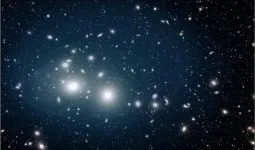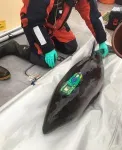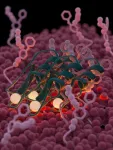(Press-News.org)
The first scientific pictures from the Euclid satellite mission have revealed more than 1,500 billion orphan stars scattered throughout the Perseus cluster of galaxies.
Led by astronomers from the University of Nottingham, this discovery sheds light on the origins of these celestial wanderers.
The Perseus cluster, located 240 million light-years away from Earth, is one of the Universe's most massive structures, boasting thousands of galaxies. However, amidst this cosmic ensemble, the Euclid satellite captured faint ghostly light - the orphan stars - drifting between the cluster's galaxies.
Stars naturally form within galaxies, so the presence of orphan stars outside these structures raised intriguing questions about their origins.
Professor Nina Hatch, who led the project team, said, "We were surprised by our ability to see so far into the outer regions of the cluster and discern the subtle colours of this light. This light can help us map dark matter if we understand where the intracluster stars came from. By studying their colours, luminosity, and configurations, we found they originated from small galaxies."
The orphan stars are characterised by their bluish hue and clustered arrangement. Based on these distinctive features the astronomers involved in the study suggest that the stars were torn from the outskirts of galaxies and from the complete disruption of smaller cluster galaxies, known as dwarfs.
After being torn from their parent galaxies, the orphaned stars were expected to orbit around the largest galaxy within the cluster. However, this study revealed a surprising finding: the orphan stars instead circled a point between the two most luminous galaxies in the cluster.
Dr Jesse Golden-Marx, a Nottingham astronomer involved in the study, commented, "This novel observation suggests that the massive Perseus cluster may have recently undergone a merger with another group of galaxies. This recent merger could have induced a gravitational disturbance, causing either the most massive galaxy or the orphan stars to deviate from their expected orbits, thus resulting in the observed misalignment."
Dr Matthias Kluge, first author on the study, from the Max-Planck institute for Extraterrestrial Physics in Munich, Germany, stated: "This diffuse light is more than 100,000 times fainter than the darkest night sky on Earth. But it is spread over such a large volume that when we add it all up, it accounts for about 20% of the luminosity of the entire cluster."
ESA's Euclid mission is designed to explore the composition and evolution of the dark Universe. The space telescope will create a great map of the large-scale structure of the Universe across space and time by observing billions of galaxies out to 10 billion light-years, across more than a third of the sky. Euclid will explore how the Universe has expanded and how structure has formed over cosmic history, revealing more about the role of gravity and the nature of dark energy and dark matter.
Dr Mireia Montes, an astronomer from the Institute of Astrophysics on the Canary Islands involved in the study said, “This work was only possible thanks to Euclid’s sensitivity and sharpness”. Euclid’s revolutionary design means that it can take images with similar sharpness as the Hubble Space Telescope, but covering an area that is 175 times larger.
END
As the European Space Agency publishes the first findings from its Euclid space telescope, scientists from the University of Surrey are celebrating fresh insights from the data.
Dr Denis Erkal, Associate Professor of Astrophysics at the University of Surrey, studies how the gravity of the Milky Way pulls clusters of stars apart, creating streams of stars trailing across the galaxy.
Now, his model for how this happens (video HERE) has been confirmed by data from Euclid.
Dr Erkal said:
“For a long time, my modelling ...
Scientists have released the first set of scientific data captured with the Euclid telescope, showing an exciting glimpse of the Universe’s distant past.
The telescope, launched in July 2023, is part of the Dark Energy Satellite Mission, which aims to map the dark Universe.
Led by the European Space Agency in collaboration with The Euclid Consortium - which includes astronomers at The University of Manchester in leadership positions – the mission seeks to unlock mysteries of dark matter and dark energy and reveal how and why the Universe looks as it does today.
Early observations, described in a series ...
What should the medicine of the future look like? A team of scientists writing in Frontiers in Science lays out a bold vision for precision approaches to understanding, preventing, and treating diseases, driven by revolutionary technologies and new interdisciplinary collaborations between researchers and other health sector professionals. The internationally renowned authors – led by Prof Michel Goldman, recipient of the Blaise Pascal Medal 2024 for his exceptional contributions to immunology and healthcare innovation, and leading microbiologist Prof Philippe Sansonetti from the Institut Pasteur and Collège ...
Peer-reviewed - survey - people
Nurses who assess patients at emergency departments would like more training and say their decisions can be negatively impacted by the high pressures of their work.
Researchers at the University of East Anglia conducted the first ever UK survey of triage nurses to discover the background, training and decision-making processes of this role in emergency departments.
Lead author Hugh Gorick, a PhD researcher at UEA’s School of Health Sciences who also works as an assistant practitioner in an NHS hospital’s Acute Medical Unit, said: “More than 24 million patients present to emergency departments ...
Water scarcity will intensify with climate and socioeconomic change, disproportionately impacting populations located in the Global South. So concludes a new Utrecht University article published in Nature Climate Change on 23 May 2024, which used a state-of-the-art global water quantity and quality model to estimate clean water scarcity until the end of the century.
Humans require clean water for drinking and sanitation purposes, but also for the production of food, energy and manufactured goods. As communities and policymakers grapple with water scarcity issues on the ground, researchers ...
A small antibiotic called plectasin uses an innovative mechanism to kill bacteria. By assembling into large structures, plectasin latches onto its target on the bacterial cell surface comparable to how both sides of Velcro form a bond. A research team, led by structural biologist Markus Weingarth and biochemist Eefjan Breukink at Utrecht University, mapped how the Velcro-structure is formed. Their discovery, published in the scientific journal Nature Microbiology, unveils a new approach that could have broad implications for the development of antibiotics to ...
LOS ANGELES — World-renowned physicians and researchers from City of Hope®, one of the largest cancer research and treatment organizations in the United States, will present new data and offer expert perspectives on leading-edge cancer research and treatments in development at the 2024 ASCO Annual Meeting, which will take place in Chicago from May 31 to June 4. Highlights include the following:
2024 Best of ASCO® program: New data on mismatched unrelated donor peripheral blood stem cell transplantation
Late-breaking data on the phase 3 CodeBreaK 300 trial
Glofitamab monotherapy for patients ...
When it comes to the animal kingdom, bigger is better. Well, at least for proboscis monkeys, famously known for their long, large and droopy noses.
Researchers from The Australian National University (ANU) have provided a world-first explanation for why male proboscis monkeys have larger and “enhanced” nasal structures.
The researchers examined the bony nasal cavity inside the skulls of proboscis monkeys and found their large noses are more than just an eye sore and in fact offer several major benefits, especially when ...
About The Study: The results of this cohort study suggest that first-seizure clinic (FSC) attendance, particularly early attendance, was associated with reduced rates of subsequent hospital utilization. This knowledge may support adequately resourcing FSCs to improve equitable, timely access. Future study directions include assessing interventions that may support FSC attendance for at-risk groups.
Corresponding Author: To contact the corresponding author, Emma Foster, M.B.B.S.(Hons), Ph.D., email emma.foster@monash.edu.
To access the embargoed study: Visit our For The Media website at this link https://media.jamanetwork.com/
(doi:10.1001/jamaneurol.2024.1187)
Editor’s ...
A new paper in Nicotine and Tobacco Research, published by Oxford University Press, shows that advertising and sales of vaping products is common on TikTok, the video sharing platform popular among teenagers. Users pushing these items often use hashtags like #puffbundles to disguise vaping products by including things like lip gloss and candy in the packages for sale.
Despite smoking rates reaching an all-time low in the United States, public health professionals are concerned about adolescent use of electronic cigarettes. In 2023 some 4.7 million (17%) middle school and high school students ...





